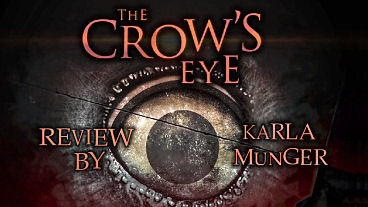
The Crow’s Eye Review
Were it not for the platformers and timed puzzles, I believe I would have enjoyed this game quite a bit despite the fact that it didn’t scare me
Category: Review
Written by Karla Munger on July 1, 2017
Developed by 3D2 Entertainment
Published by Nkidu Games Inc.
Platform: Windows
Genre: First-person Puzzle-Platformer
Release date: March 20, 2017
I’ve never felt so ambivalent about a game. At first, I wasn’t too impressed. But I came to realize that some of my negative feelings emanated from my shortcomings as a gamer, and that I was being unnecessarily critical. Until I was able to get past this, I was unable to appreciate the game’s positive aspects.
This will be a detailed review. I hope to make potential players aware of what they’re getting into. I had no such benefit.
The Crow’s Eye is not a bad game. It’s actually a pretty good one, subject to certain conditions. I hope to make these conditions clear in what follows.
The game is billed as a “first-person puzzle adventure” that’s “set against a backdrop of psychological terror.” I have a problem with this description.
Yes, there are puzzles. Quite a few, actually, and none is inordinately challenging. Some are logic-based; some involve the environment. Okay — no problem here, unless you prefer consistently difficult puzzles.
The game includes quite a few platformers. I’m disappointed that this fact isn’t mentioned in the many descriptions of the game I’ve come across. For me, this does represent a problem. More about platformers in a bit.
Now…a backdrop of psyhological terror? (I prefer the term “psychological horror,” which removes the concept from the realm of terrorism — something we’re not concerned with here.) No matter what you call it, however, I found no horror in The Crow’s Eye.
The game does have jump scares. Objects crash to the floor; there are abrupt noises; things leap out at you a few times. As I’ve been known to say, there is nothing scary about jump scares. They startle, and that’s all. One or two of them go a lo-o-o-ng way with me. If there are too many, I become really annoyed.
Fashioning effective psychological horror in a game can be tricky and difficult to accomplish. This kind of horror must arise from within the player, not directly from external events that result in instictive reactions.
Let’s say you’re playing a game that has some big, bad nasties. As you’re inching down a dark corridor, one of them drops from the ceiling and lands in front of you (jump scare). Its sole purpose is to kill you.
You have two choices: (1) Stay and try to kill it first, or (2) Run. This is the primitive fight-or-flight instinct, which all animals possess. It’s not psychological horror.
Horror of the psychological variety must build slowly and continuously within a player’s mind and imagination, spurred on by a game’s atmosphere. Fear of the unknown is the most powerful form of fear. A player’s psyche can conjure up all sorts of awful things with which to fill in the blanks, so-to-speak.
In essence, this kind of fear must induce players to scare themselves by making them feel increasingly anxious, vulnerable and full of free-floating dread.
In such an atmosphere, waiting for something to happen can be excruciating. If nothing happens for quite awhile, the player can become an emotional wreck. I know, as it’s happened to me.
I love this kind of horror. Unfortunately, games that have successfully conveyed it have been few and far between in my experience.
The storyline of The Crow’s Eye is somewhat reminiscent of Corrosion: Cold Winter Waiting which, in my opinion, is an effective psychological horror game. It genuinely scared me.
I’ve also noted the influence of such games as Bioshock and Amnesia.
Although The Crow’s Eye does have elements of psychological horror here and there, the effect, in my case, was repeatedly derailed by the intrusion of feelings that are not horror-related (frustration, for instance). I suppose it doesn’t help that I have a high fear threshold.
Okay, back to the story.
I, as the nameless protagonist, come to consciousness inside Crowswood University, a once-prestigious medical school. In 1947, a number of students and faculty had disappeared from the facility. No remains had been found, no leads had been developed and Crowswood was shut down.
It’s now 1966 and here I am, trapped inside the school. I don’t know my identity or what I’m doing here.
As I explore the room in which I find myself, I discover it has objects that can be picked up and thrown or dropped. Either way, they break.
I love breaking things. I proceed to break everything I can find. Glass flies all over the place. Hitting one breakable object with another causes an impressive explosion of fragments.
I realize this is all pretty juvenile, but I think it’s fun. And I don’t even have to clean any of it up when I’m finished.
After playtime, I find and listen to an audio tape — the first of many that, along with letters to and from various people, will help piece the story together. I also pick up a lighter, find a key to unlock the only door and leave the room.
Shortly thereafter, a public address system springs to life and I’m treated to a voice that sounds as though it belongs to a graduate of the Joker School of Elocution. To describe it as manic is an understatement. A small portrait of the person who’s speaking is displayed at the screen’s upper left. It rather resembles Henry Wadsworth Longfellow. (It turns out to be William Holtwick, the facility’s head honcho and resident lunatic.)
I’m told I’m participating in an experiment, and that I’ve been here before. I have no memory of this.
I’m also told I’m being watched. Yes, I see the cameras now.
I’ve been furnished with a rudimentary map. The Voice tells me to take as long as I want (for what?) and, after saying, “let the show go on,” goes poof. (For those who don’t care for The Voice and its delivery, know that there are long stretches during which it remains silent.)
Not having been told what’s expected of me, I set out to explore the university. I subsequently discover it’s enormous.
Bits and pieces concerning some nasty activities taking place at the university are revealed as one progresses through the game’s nine levels. Unfortunately, not enough is revealed to form a meaningful whole.
Things are more-or-less tied together at the very end via a six-minute expository dump. The player just sits and listens. Not everything is explained, however, and the story’s resolution — such as it is — feels rushed. I was left with unanswered questions.
The game is played with keyboard and mouse. Just about every control you can think of can be customized/remapped. Being left-handed, I’m beyond grateful for this. I’ve played games having limited control-adjustability that are obviously meant for right-handers; in those cases, I’ve had to twist my fingers around in difficult and sometimes untenable positions in order to accomplish certain maneuvers.
The Crow’s Eye helps you along by reminding you which control to use when confronted with an interactive object. When it does so, it picks up on any key bindings you may have changed.
You can also choose to have all interactive items highlighted. This is actually the default setting. It can be turned off in Options.
Saves are accomplished via pre-designated save points. You must return to these no matter where you are when you want to save the game. Then, when you load the save, you’re taken to the save point and must make your way back to where you’d actually been.
I really don’t care for this kind of save mechanic. I much prefer the ability to save right where I am.
A small version of your map is displayed at the lower RH side of the screen. At that size, I found it less than helpful; it indicates your location relative only to your immediate surroundings.
As you travel through each level, more areas of the map are revealed. To view it in its entirety, the map can be expanded. Unfortunately, it displays in the middle of the screen, thereby obscuring the center of the player’s field of vision.
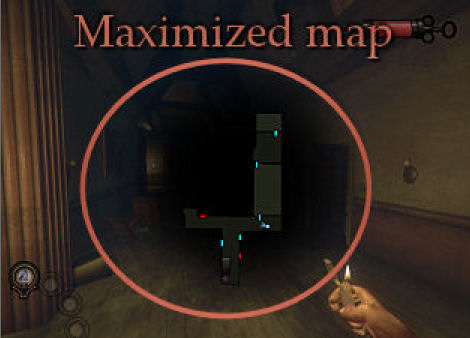
I really could have benefited from keeping the map expanded. I tried doing so, but frequently ran into things that impeded my progress. This became rather tedious and I ultimately abandoned the idea.
The game also has an inventory and simple crafting system in which you combine objects to make useful items. The above-referenced map, for instance, is only provided in the first level. Thereafter, you must craft one.
The puzzles in The Crow’s Eye involve such activities as pushing blocks around, finding and turning on switches and levers, and picking locks. Some are repeated. A couple of them are timed. There are also two mazes.
One of the timed puzzles hung me up pretty badly. It takes place outside, at night, in a partially wooded area in the rain.
I’m to locate three items, none of which is reflected on the map, of course. I have a dreadful sense of direction, but I had already seen two of the objects earlier as I’d been wandering around the area.
Blast off! I careen through tall grass, vegetation and low-hanging branches, smash into tree trunks, run into fences and bounce off gates.
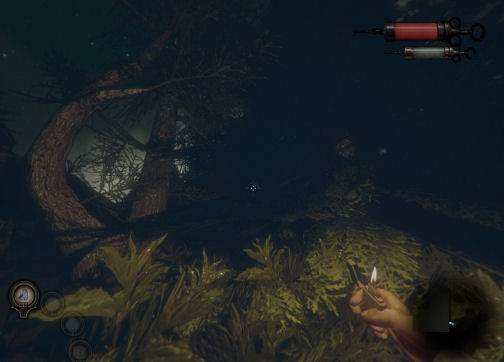
Where am I? I’m stuck! How do I get out of this? I fumble the map open.
Time’s up!!!!!
Repeat, repeat, repeat.
I decide to get out my notebook, wander around again until I find each item, and draw a map to show the item relative to my location according to the game’s map. I’m still unable to locate the third item, but maybe fate will be kind…
Blast off! I actually find one of the objects. Eureka! My map is working! Then I find the second one. Oh, happy day! Then…
Crap! Where’s the third one? (Smash, crash, bounce.)
Time’s up!!!!!
Sigh…
The game also has many increasingly complex 3D splatformers platformers. Some have moving parts; some are stationary. The jumps to be made require varying degrees of precision.
I’m klutzy and uncoordinated, even in a virtual milieu. I don’t get along very well with platformers. One or two are okay, but that’s it.
Just before the first platformer I find a tool called Adrenaline. It doesn’t speed up the player; it slows everything else down and enables jumps of greater distances. (Point of possible interest: if you activate Adrenaline while listening to an audio tape, the playback slows down and sounds real funny. I discovered this by accident. Honest.)
Fortunately, Adrenaline replenishes itself almost immediately. Unfortunately, use of the substance in combination with running and jumping requires pressing four keys. Have I mentioned I’m an uncoordinated klutz?
So…I miss a jump and go splat on the floor. I miss another and tumble into an apparently bottomless void.
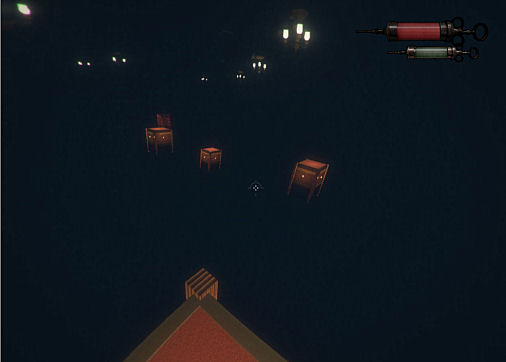
I hit the side of a platform, bounce off and go splat on the ground. I slip and fall into some kind of noxious liquid (I guess that would be splash, not splat). I’m ground up by moving gears (squish).
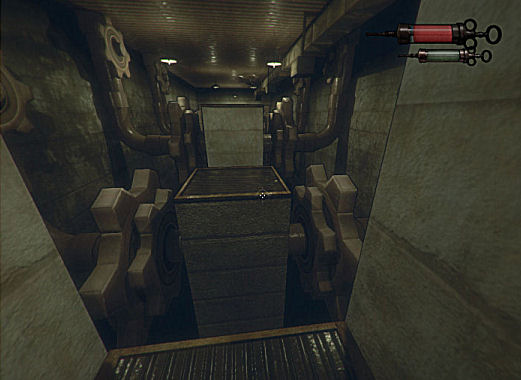
Interestingly, if I’m killed, I’m returned to the point just before I screwed up. If I survive, I have to repeat the platforming sequence from the beginning. This is the first game in which I’ve actually wanted to die. Repeatedly.
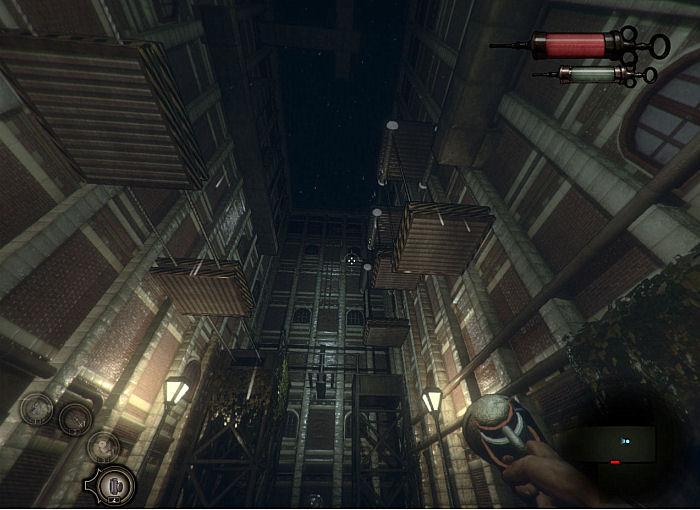
One of the moving platformers requires the player to grab hold of a ladder which is located halfway up the side of a square vertical structure around which platforms are rotating. After I finally reach the ladder, I climb the first couple of rungs, slip off and land back on the platform from which I’ve just jumped (splat). It proceeds to move out from under me and I go splat on the ground. Oh good. A double-splatty.
Compounding my platforming problems is the fact that The Crow’s Eye is played in first-person. When one is trying to get as close as possible to the edge of a jump-off point, looking down doesn’t yield an accurate picture of one’s position. It can appear as though one is standing in mid-air when one is actually on a solid surface. Under these conditions, it’s easy to misjudge one’s position and fall off, or jump too soon and miss the target. Splat/splash/squish.
I’m not having any fun.
Fortunately, the game’s crafting system includes a way to make bandages that have healing properties. These come in handy when, for example, I miss a jump, land head-first on a hard surface and crack my skull open.
The bandages are also useful after I run head-on into tree trunks and other solid objects and crack my skull open.
All of this splattery, splashery and squishery gets me nowhere and leaves me feeling exasperated. More than once, I had to walk away from the game entirely in order to avoid upsetting my neighbors, my computer and/or my cat’s ashes with all of the four-letter words (including many f-bombs) straining to leap from my mouth at high volume.
Later in the game, I find material I can craft into a combination flashlight-electromagnetic device. This propels/repels the player straight to a target rather than having to jump to it. I get to zoom around really fast, which is something I love to do. This tool is more helpful than Adrenaline, although it only works in certain areas.
Music, Sound and Voice-Overs
This game’s music, by Manuel P. Perez, is absolutely outstanding. It’s of cinematic quality and enhances the narrative beautifully. In fact, I consider it to be the best part of the game. I’ll include a sample down by the trailers. FYI, the soundtrack may be purchased as a standalone from the Steam page.
Sounds are realistic and effective. Storms roll through, bringing thunderclaps — some quite loud and abrupt. Although I suppose these could be considered jump scares, they do add to the game’s atmosphere.
The voice-overs on the tapes are well-executed, and I particularly enjoyed the frenetic voice of actor Ryan Wiley (Holtwick) as it accompanied me through the game. Mr. Wiley has a field day chewing the scenery; his delivery is so over-the-top I think it’s funny.
The Crow’s Eye can be dark in presentation, necessitating almost continuous use of one’s lighter or flashlight. Fortunately, the lighter always has fuel and the flashlight’s batteries never die. Thank you, developers.
Also, what appears to be moonlight streams in through windows and helps light the player’s way.
The graphics, while not exactly state-of-the-art, are well-done. However, some of the assets, such as a piano and grandfather clock, are used repeatedly.
I’m going to try to balance this review between the game itself and the appeal it holds for me, keeping my shortcomings in mind.
I am painfully aware that I’m likely the most platformer-challenged gamer on the planet. As such, some of the responsibility for failing so abysmally at the game’s platforming lies with me. It’s not the developer’s fault that I’m so uncoordinated.
But the developer does carry some of the burden, I think. Including so many platformers is overkill. They do little to advance the narrative and, in my case, detract from it by breaking immersion and continuity in a big way.
The platformers also interfered with any potential fear the game might have held for me. I can feel afraid or exasperated, but I’m unable feel afraid and exasperated.
I never really felt at-risk while playing The Crow’s Eye. Whatever may have been taking place at the university intrigued me and piqued my curiosity, but fear didn’t enter into the equation. I suppose it didn’t help that I kept throwing breakable objects around (plenty of them are to be found throughout the facility). Also, The Voice kept cracking me up, and the platformers kept inspiring urges-to-kill. This left little room for at-risk feelings.
Further, as previousy mentioned, I’m difficult to scare. I’m sure there are plenty of gamers who aren’t as desensitized to horror as I am, and who would find this game scary enough.
The Crow’s Eye does have some creepy aspects. Had I not been so distracted, I’m sure I would have appreciated those aspects more.
I really don’t want to leave you with the wrong impression concerning The Crow’s Eye. The game was five years in the making, and you can tell that the small team at 3D2 Entertainment worked hard on it. It’s their first game and I think they did a skillful job. Were it not for the platformers and timed puzzles, I believe I would have enjoyed it quite a bit despite the fact that it didn’t scare me.
Should 3D2 make another game, I hope the puzzles/activities/difficulty levels will be more balanced. And should it be a psychological horror game, I hope the horror aspects will be more subtle and the jump-scares kept to a minimum.
The Hole has been released by the developer. It’s free. It puts players in the shoes of Jack Meiwes, one of the missing students. It downloaded automatically when I fired up the game, so I decided to give it a try and include it in this review.
The game had touched on some side-stories that had interested me, but there was little elaboration. I welcomed this add-on, as I hoped it would go into more detail concerning the ultimate fate of this student.
(Opens DLC…)
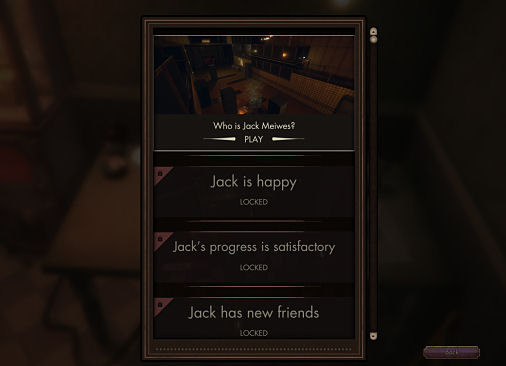
Oh, no. No-no-no-no. Jumpers and platformers, right off the bat. And it appears as though the whole thing is timed. Have I fallen into Hell?
I doggedly start tackling things. I’m actually successful at the first few jumps. Then…splat. Repeatedly.
I make a dozen attempts to surmount the same platformer, and go splat a dozen times. Then I do something I absolutely detest doing: I give up.
Games are supposed to be fun. For me, this kind of thing isn’t fun. So I’ve taken up residence in The Land of I-No-Longer-Care-What-Happens-Next. I’ve had enough.
I later discover the following text from the developer concerning the DLC:
“Meet Jack Meiwes, one of the missing students in Crowswood University, where other people also went missing and which led to a Police investigation.
“The player will have to solve a series of puzzles… and the difficulty has been increased! In addition, each level displays a counter that tracks the time you’re taking. Who will be the first to find out what happened to Jack Meiwes?”
Okay, now I really must say something to 3D2 Entertainment.
Have a heart, guys. Please don’t create games that are loaded with too much of the same thing. Different gamers have different strengths and I, for one, don’t enjoy playing games that are top-heavy with Things At Which I Stink and that repeatedly collapse on me.
And please be a little more precise concerning the nature of the activities in your games, even if only in the genre/description. I think The Crow’s Eye could be more accurately categorized as a First-Person Puzzle-Platformer (after all, platformers are the most prominent feature of the game) rather than a First-Person Puzzle Adventure. And while the game does present a mystery, platforming and horror don’t mesh well from where I sit. In fact, I find the combination somewhat jarring. If you make another horror game — and I hope you will — you might want to lose the platforming altogether.
End of rant.
Finally, I’d like to make potential players aware of a couple of things. It appears that the game has been through some major changes since its inception.
Some of the trailers and videos posted on YouTube by the developer in 2014 feature content that is not present in the final version of the game. These also appear in some of JA’s coverage of The Crow’s Eye from 2014.
Further, you may have seen mention of enemies the player must confront. For instance, the following appeared on the game’s Kickstarter page (also from 2014): Observe the enemy: Advance stealthily and beware the enemies’ moves. Search their weaknesses in order to confront them, use crafted items or those in your surroundings to stun them. There is a broad range of enemies in the different levels, each worse than the other, so make sure you are ready before advancing, or you will last little to no time alive. Also: Each enemy will have its weaknesses. The player will have to learn the behavioral pattern, and, once discovered, decide which strategy to use in order to survive.
There are no enemies of this nature in the game’s final version. The player is physically alone for a majority of the game.
I’m going to assign two letter grades to The Crow’s Eye:
B for those who favor sliders, jump scares and timed puzzles
C- for those who don’t
If you’re in the latter group, you might want to skip the game and just buy the soundtrack.
|
+ The music is outstanding
+ Controls are plentiful and highly customizable
+ Some clever tools are introduced
+/- Platformers, jump scares, timed puzzles and mazes
– Can be quite frustrating
– Isn’t scary
– Some might find the puzzles too easy
– Resolution is achieved by an expository dump; it feels rushed and leaves the player with unanswered questions
– Obsolete info appears online that may mislead players concerning the game’s content
|
 |
System Requirements
Processor: Intel Core i3 or equivalent
Memory: 4 GB RAM
Graphics: NVIDIA GeForce GTX 460 or equivalent
Storage: 3 GB available space
Leave a Reply